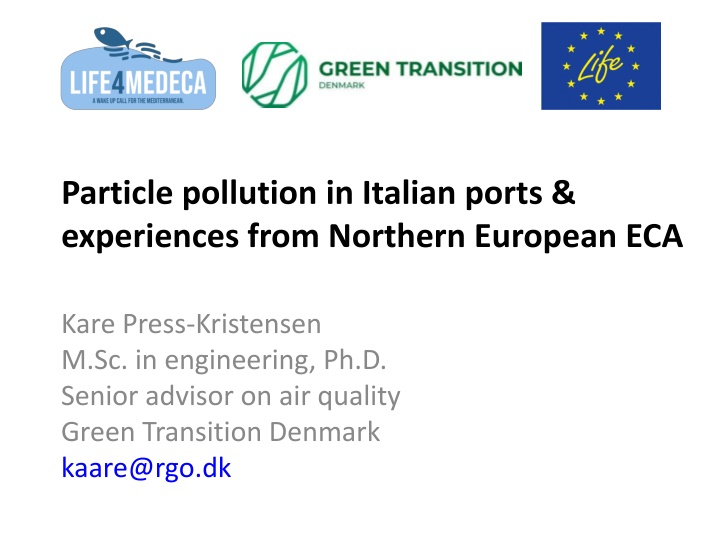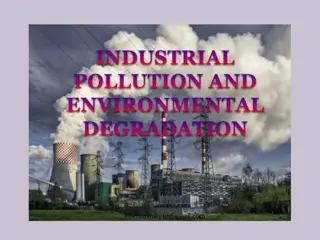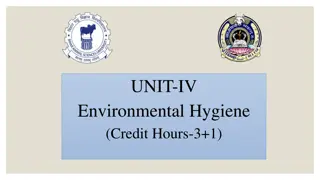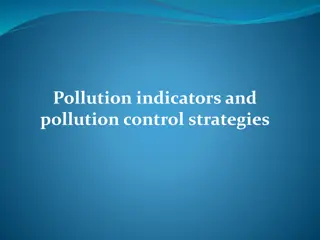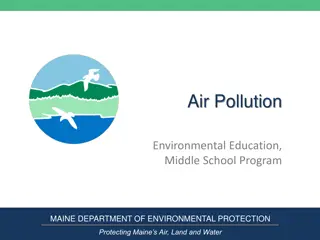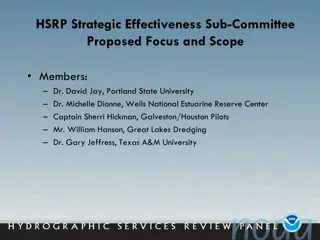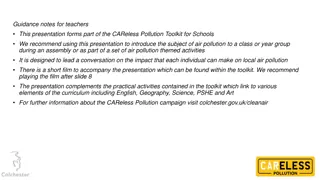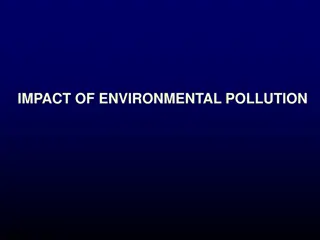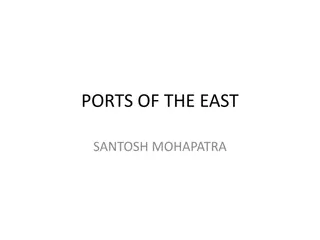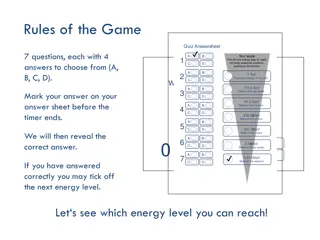Impact of Particle Pollution in Italian Ports: Insights from Northern European ECA
Particle pollution in Italian ports poses a significant health risk, with around 65,000 deaths annually attributed to air pollution. Shipping emissions contribute substantially to this issue, highlighting the urgent need for tighter regulations and cleaner technologies in the maritime industry.
Uploaded on Sep 17, 2024 | 4 Views
Download Presentation

Please find below an Image/Link to download the presentation.
The content on the website is provided AS IS for your information and personal use only. It may not be sold, licensed, or shared on other websites without obtaining consent from the author.If you encounter any issues during the download, it is possible that the publisher has removed the file from their server.
You are allowed to download the files provided on this website for personal or commercial use, subject to the condition that they are used lawfully. All files are the property of their respective owners.
The content on the website is provided AS IS for your information and personal use only. It may not be sold, licensed, or shared on other websites without obtaining consent from the author.
E N D
Presentation Transcript
Particle pollution in Italian ports & experiences from Northern European ECA Kare Press-Kristensen M.Sc. in engineering, Ph.D. Senior advisor on air quality Green Transition Denmark kaare@rgo.dk
Health effects of air pollution in Italy Around 65,000 people die from air pollution every year in Italy (EEA, 2020). That is 10.5% of all deaths (630,000). In 2020-22 air pollution (195,000) killed more people in Italy than COVID (180,000). No vaccine against pollution. If air pollution from shipping causes just 10% of deaths due to air pollution shipping kills 6,500 Italians per year. Cancer, cardiovascular diseases and airway diseases etc. It is very cost effective to reduce air pollution from ships.
Shipping is poorly regulated Sulphur in marine fuels vs. road fuel 40000 35000 35000 30000 25000 25000 20000 15000 10000 10000 5000 5000 1000 10 0 Former global limit Former global average SECA limit 2010-14 Global limit 2020 SECA limit 2015 Road transport 2010 (EU) 2014: All new trucks in EU have very effective exhaust gas cleaning systems no ships have filters or catalytic converters !
Trucks have filters Ships have no filters Ships have no filters. A cruise ship (4,000 p.) at berth emits as many particles as 5,500 cars per second. Piombino Oct. 6th, 2021 Wind: 6-8 m/s.
Genoa: A cocktail of bad conditions A lot of polluting ferries and cruise ships inside the heart of the city for most of the year. The city almost covers a circle around the port so pollution plumes will hit residential areas most of the time. City is built uphill, so chimneys are in same height as windows. Have a warm climate so people spend much time outdoor, and windows are open when it is warm = when you have cruise ships. Still no shore power for cruise ships and ferries.
Measurements of air quality in Italy Measured ultrafine exhaust particles. Particles smaller than 100 nm consisting of soot (black carbon) coated with PAHs and heavy metals. Ultrafine particles are deposited in the finest parts of the lungs (alveoli) and transferred into the blood. Clean air in Europe contains 1,000- 3,000 particles per cm3.
Genoa with/without cruise ship: 6-10 m/s Without cruise ship With cruise ship
Genoa upwind cruise ship ferry: 9 m/s Genoa, October 24, 2022
Livorno upwind and downwind ferry: 11 m/s Down-wind: After ship Up-wind: Before ship
Piombino upwind/downwind ferry: 6-8 m/s Up-wind: Before ship Down-wind: After ship
2021: Civitavecchia with/without wind from sea No wind: Evening Oct. 1st 8 m/s from West: Oct. 6th
2021: Civitavecchia with/without wind from sea 8 m/s from West: Oct. 6th No wind: Evening Oct. 1st
Civitavecchia: The pollution hits the city 8 m/s from West: Oct. 6th 2021
Results from measurements Particle pollution (average particles per cm3) 1.600 71.650 2.250 60.550 2.350 82.400* 1.250 50.650 2.150 45.550 7.100 Wind Date Ship (direction : speed) W : 1-2 m/s W : 8-9 m/s W : 1-2 m/s W : 8-9 m/s Oct. 1st Oct. 6th Oct. 1st Oct. 6th Oct. 4th Oct. 4th Oct. 5th Oct. 5th Oct. 6th Oct. 6th Oct. 7th City background With ship pollution City background With ship pollution Sea background With ship pollution Sea background With ship pollution Sea background With ship pollution Rush hour traffic --- Civitavecchia Ferries --- Cruises --- Cruise --- Ferries --- Ferries Cars Civitavecchia Genoa E : 6-10 m/s Livorno SW : 9-12 m/s Piombino W : 6-8 m/s Rome city centre 4-5 m/s Shipping cause significant pollution of Italian port cities.
Measuring report Report with screening measurements from Italian port cities: https://rgo.dk/wp- content/uploads/Air- pollution-from-shipping- in-Italian-ports.pdf
Emission control area in Northern Europe SOx Emission Control Area from 2007 with the strictest sulphur limit from 2015. NOx Emission Control Area from 2021 for all new build ships.
Measurements from Northern Europe Before SECA After SECA Measurements from Neuwerk (German island) Concentrations of toxic SO2immediately dropped, as expected, after introducing the SECA
Control and enforcement EU: - Min. 10% inspections and 4% sulphur analysis. - Fines must prevent systematic violations. DK: - Helicopters measuring sulphur, NOx and CO2 directly in the ship exhaust fan at sea (600/yr.). - Name and shame on ship/companies violating.
Conclusions from Northern European ECA Plenty of distillate fuel (0.1% sulphur) available. High reduction in sulphur on land (50% drop in 2015). Significant health and economic benefits for society. No enforcement challenges (0.0067% violations). No cargo transfer from ship to road. No notable price increases for consumers (< 0.005%). No notable extra costs for ship owners or authorities.
Solutions for ship pollution In ports: Shore power for cruise ships, ferries, cargo ships, etc. At sea: Electric ferries Great potential. Particulate filters for ships (removes > 95%). Emission Control Areas (ECAs) limiting emissions: - SO2emissions will drop 80% immediately. - NOx emissions will drop 80% over 20-25 years. - Particle emissions will drop significantly and immediately.
With support from EU: LIFE4MEDECA This presentation is part of the EU LIFE project: LIFE4MEDECA with the purpose to designate a Mediterranean Sea Emission Control Area to reduce health hazardous and climate damaging emissions of air pollution from ships.
NOx from ships in Northern Europe Adverse health effects: 42 per kg NOx emission. Removal costs: 2 per kg NOx removed (using SCR). Society saves around 42 billion in health damages every time society invests 2 billion in NOx-removal Rate of return: 2.000% ! + less damages on crops, constructions, ecosystems, etc. A NOx ECA is the best investment you can imagine
Control and enforcement EU: - Min. 10% inspections and 4% sulphur analysis. - Fines must prevent systematic violations. DK: - Helicopters measuring sulphur, NOx and CO2 directly in the ship exhaust fan at sea (600/yr.). - Name and shame on ship/companies violating.
Shipping is poorly regulated Sulphur in marine fuels vs. road fuel 40000 35000 35000 30000 25000 25000 20000 15000 10000 10000 5000 5000 1000 10 0 Former global limit Former global average SECA limit 2010-14 Global limit 2020 SECA limit 2015 Road transport 2010 (EU) 2014: All new trucks in EU have SCR & particulate filters!
